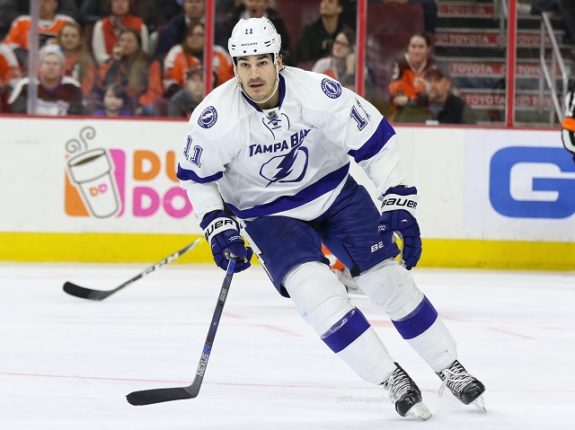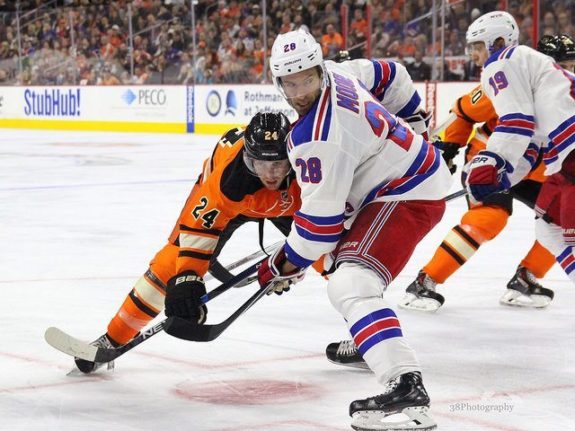Losing Brian Boyle in free agency was a big loss to the Toronto Maple Leafs. Although he was only with the team for a short time, Boyle gave everyone confidence in the fourth line. He could win those crucial defensive-zone faceoffs and kill penalties, and he made full use of his 6-foot-7 frame every shift. But now he’s playing for the New Jersey Devils and it’s up to Dominic Moore to fill that void on the Leafs’ fourth line.
Dominic Moore Back in Toronto
This will be Moore’s second stint with the Leafs as he previously played for the Leafs back in the 2007-08 and 2008-09 seasons. Moore came to the Leafs as a waiver claim from the Minnesota Wild partway through the 2007-08 season after only having three points in 30 games. He then finished the season with 17 points in 68 games.
The 2008-09 season was a big change for both Moore and the Leafs. The team decided not to re-sign Mats Sundin and so he left to go sign with the Vancouver Canucks, which made the Leafs significantly worse. This resulted in Moore getting the chance to play further up in the lineup, and he ended up developing great chemistry with winger Jason Blake. This ended up being Moore’s career season with 41 points in 63 games.
Moore never finished the season with the Leafs as he was traded to the Buffalo Sabres for a second-round pick in the 2009 draft. From there he bounced around to six different teams with his longest stay being three seasons with the New York Rangers, the team that originally drafted Moore.
When Moore first came to the Leafs, it was a team destined for years of obscurity with no hope in sight. Now he’s playing for one of the youngest and most promising teams in the NHL. A lot has changed in a decade.
Moore Compared to Boyle
So with Moore back in Toronto, how does he stack up against Boyle as the Leafs’ fourth-line center? Presuming that coach Mike Babcock will use Moore in the same way that he used Boyle in the lineup, then the aspects to look at will be: faceoff win percentage, possession, zone usage and point production. From that, we should get an idea of whether Moore is a good replacement for Boyle.
Faceoffs
This is one of the most important aspects when comparing the two players when you consider that Babcock tends to deploy the fourth-line center defensively. In his 21 regular-season games with the Leafs, Boyle took 251 faceoffs and had a faceoff win percentage (FOW%) of 51. When broken down by zone it comes out to a 67.6 FOW% in the offensive zone, 42 FOW% in the neutral zone, and 52.7 FOW% in the defensive zone. When shorthanded, his FOW% dropped to 44.9.

Those faceoff percentages are pretty close when compared to Moore. In 82 regular-season games with the Boston Bruins, Moore took 654 faceoffs and had a 54.6 FOW%. Moore did better overall with a 58.4 FOW% in the offensive zone and a 59.5 FOW% in the neutral zone, but he struggled in the defensive zone compared to Boyle with just a 49.7 FOW%. Shorthanded, Moore is comparable to Boyle with a 45.9 FOW%.
So when comparing the two at faceoffs, Moore is actually better overall but is worse in the defensive zone compared to Boyle.
Possession
Puck possession is a good way of comparing these two defensively-used centers. If a player is used most often in the defensive zone and they have good possession stats then it would equate to how often they can get the puck out of their own end. So in measuring possession, we have to look at Corsi. It involves Corsi-for, which is all the shots taken that hit the net, miss or are blocked and put up against Corsi-against, which is all the shots that the opposing team takes.
This is then expressed as a percentage, Corsi-for percentage (CF%), and anything over 50 percent is considered positive as that player takes more shots than his opponent when he is on the ice. This gives us a rough way to gauge possession since you can’t shoot the puck unless you’ve got it.
This past season, Moore had a 47.9 CF% and took 40.21 percent of his faceoffs in the defensive zone (DZFO%). Now compare this to Boyle, who had a 52.7 CF%, but had just a 35.32 DZFO%. So at face value, Boyle is clearly the better possession player. But the players’ zone usage would play a large part in their CF% and put the defensively-used player at a disadvantage.

Moore has spent the last four seasons with over a DZFO% over 40 while Boyle has split the majority of his faceoff time between defensive and neutral zone faceoffs. So if we go back to a season when Boyle had a DZFO% over 40, then it could give a better comparison between the two.
Conveniently, both players played for the Rangers back in 2013-14 and each had a 49 DZFO%. In that season, Moore had a 48.5 CF% and Boyle had a 47.1 CF%. So based on similar usage, I would assert that Moore is just as good of a possession player as Boyle.
Point Production
Lastly, we can compare the two in terms of point production. In terms of comparing their overall points per game, they are essentially the same player.
Moore just has a slight edge with 0.32 points per game while Boyle trails with 0.28 points per game. Some of the difference here can be the result of Moore having played 148 more games than Boyle. Ultimately it means that each is likely to get around 20 points a season, which has been the case if you look back through their career totals.
Moore Is Just as Good and Cheaper
When Boyle came to the Leafs from the Tampa Bay Lightning, he instantly improved the team and helped give the young Leafs a great run in the playoffs. So everyone was surprised to hear that they wouldn’t be bringing Boyle back and that he had signed with the New Jersey Devils on a two-year, $5.1 million contract.
Then the Leafs announced that they had signed Moore to a one-year, $1 million contract. It looked like a step down in the quality of player at the cost of saving money when the Leafs could easily have afforded Boyle. But when looking at the comparisons between the two players, it’s obvious that the Leafs made the right decision.
Moore is just as good of a player as Boyle, if not better in certain areas, and he costs less for the Leafs than if they were able to re-sign Boyle.